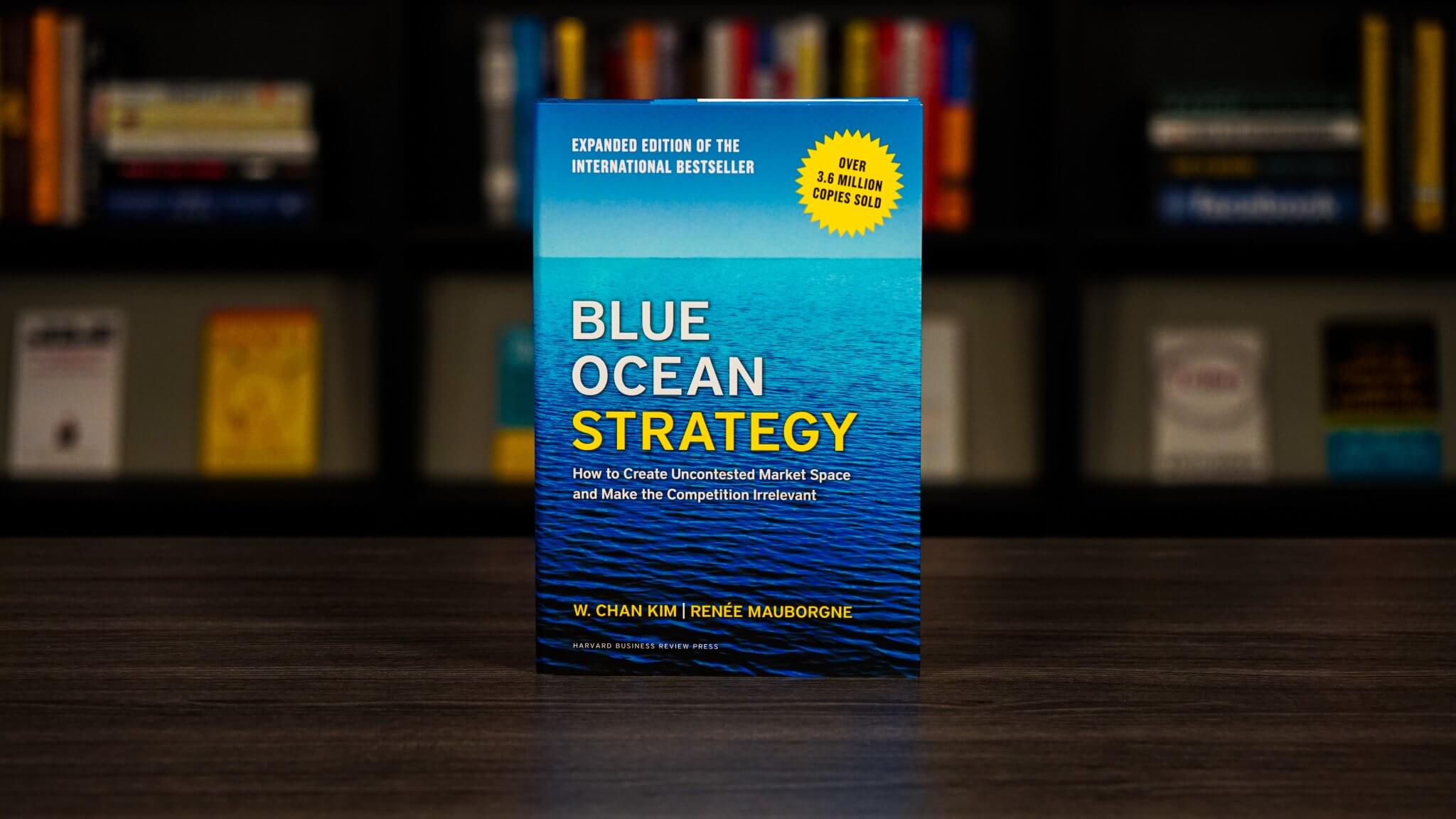Most industries are driven by cutthroat competition. This results in a bloody red ocean where rivals fight over shrinking profits. Blue Ocean Strategy offers a systematic approach for making the competition irrelevant by creating uncontested market space.
The book is for founders, entrepreneurs, marketers, or anyone else interested in creating unique value for customers. This includes startups that want to avoid competition. As well as established businesses that want to separate themselves from rival brands.
1. Escape The Bloody Competition of Red Oceans
Red oceans represent all of the industries in existence today. The known market space. Common strategies for navigating these waters include: outpacing the competition, capturing existing demand, segmenting customers by their preferences, and either offering additional value or lowering costs.
Blue ocean strategy challenges companies to break out of the red ocean of bloody competition and create uncontested market space. This involves creating and capturing new demand, breaking the value/cost trade-off, and redefining market boundaries to create a leap in value for buyers.
The core principle of blue ocean strategy is value innovation. It places equal emphasis on value and innovation. It’s not just about technology innovation or being first to market in a new category. Instead, it’s about redefining the problem, crossing market boundaries, and unlocking exceptional value for buyers.
2. Reconstruct Buyer Value with The Strategy Canvas
The Strategy Canvas is a diagnostic and action framework for building a compelling blue ocean strategy. Use it to analyze the current state of play in the known market and to reconstruct buyer value.
It starts with a simple line chart. The horizontal axis lists factors that the industry competes on, while the vertical axis measures the value that buyers receive across each factor. Use this chart to plot how individual businesses score in terms of the value they offer across each factor. The ‘value curve’ that results from connecting the dots for a given business is a visual representation of their market strategy.
The real power in this tool is in fundamentally shifting the strategy canvas of an industry. This involves reorienting your strategic focus from competitors to alternatives, and from customers to non-customers of the industry. Seek to understand the core problem that both customers and noncustomers are trying to solve, and then define the factors that have the greatest impact on solving that problem.
Resist the old urge to outcompete other businesses on established industry factors. Instead, consider the following four questions in order to reconstruct buyer value:
- Which of the factors that the industry takes for granted should be eliminated?
- What factors should be reduced well below the industry’s standard?
- Which factors should be raised well above the industry’s standard?
- What factors should be created that the industry has never offered?
These four questions help to (1) eliminate what buyers no longer value, (2) reduce over delivery that often results from competitive benchmarking, (3) raise value in areas that appeal to buyers, and (4) create new value to attract former non-customers into the market.
3. Redefine Market Boundaries To Escape The Competition
Businesses in red oceans tend to view their industry within established market boundaries. They define the space in a similar way to competitors and focus on being the best within it. However, instead of looking within these boundaries, managers need to look across boundaries using the six paths framework.
Path 1: Look Across Alternative Industries
In making every purchase decision, buyers implicitly weigh alternatives, often unconsciously. People go to a restaurant for the same objective that they go to the movies: to enjoy a night out. These are not substitutes, but alternatives to choose from. What are the alternative industries to your industry? Why do customers trade across them?
Path 2: Look Across Strategic Groups within Industries
What are the strategic groups in your industry? Rank each one in rough hierarchical order based on price and performance. Why do customers trade up for a higher group, and why do they trade down for a lower one?
Path 3: Look Across the Chain of Buyers
Most industries have a common definition of who the target buyer is, but in reality there’s often a chain of “buyers” who are involved (purchaser, end user, influencer, etc.). Who is in the chain of buyers for your industry? Which buyer group does the industry typically focus on? Could you unlock new value by shifting the buyer group of your industry?
Path 4: Look Across Complementary Product and Service Offerings
Products and services are rarely used in isolation. In most cases, other products and services affect their value. Determine the context in which customers use your product or service. What happens before, during, and after? Can you identify any pain points? How can you eliminate these pain points through a complementary product or service offering?
Path 5: Look Across Functional or Emotional Appeal to Buyers
Some industries compete primarily on functionality while others compete largely on emotions. If your industry competes on emotional appeal, what elements can you strip out to make your offer more functional? If it competes on functionality, what elements can you add to make your offer more emotional?
Path 6: Look Across Time
All industries are subject to external trends that affect their businesses over time. Think of the rapid rise of cloud computing or the global movement toward environmental protection. What are the trends that have a high probability of impacting your industry? How can you leverage those trends to create unprecedented customer utility?
By using these paths to think across conventional boundaries, you can make convention-altering, strategic moves that reconstruct established market boundaries and create blue oceans.
4. Attract Non-customers To Expand Your Blue Ocean
In red oceans, competing businesses fight to capture existing customer demand. But to create blue oceans, companies need to take a reverse course. Instead of fighting over existing customers, they need to seek out non-customers. And they need to build on powerful commonalities in what people truly value.
There are three tiers of noncustomers that have the potential to be transformed into customers:
1. First-Tier Non-customers
These are “soon-to-be” non-customers who use the current market offerings to get by as they search for something better. This group tends to offer far more insight into how to unlock and grow a blue ocean than do relatively content existing customers. Why does this group want to leave your industry? Focus on the commonalities across their responses, not on the differences between them.
2. Second-Tier Non-customers
These are “refusing” noncustomers, people who either do not use, or cannot afford to use, the current market offerings because they find them unacceptable or beyond their means. What are the reasons they refuse to use the products or services of your industry? Again, focus on the commonalities across their responses, rather than the differences between them.
3. Third-Tier Non-customers
These “unexplored” non-customers have not been targeted or thought of as potential customers by any player in the industry. That’s because their needs have somehow always been assumed to belong to other markets. Think of the long-held assumption that tooth whitening was a service provided exclusively by dentists and not by oral care consumer-product companies.
There is no hard-and-fast rule to suggest which tier of non-customers you should focus on first. However, by focusing on key commonalities across these groups, in addition to existing customers, businesses can understand how to pull them into their blue ocean strategy.
5. Follow All Four Steps in the Strategic Sequence
To build a robust business model, companies need to address: (1) buyer utility, (2) strategic price, (3) target cost, and (4) adoption. Assessing blue ocean ideas along the criteria in this strategic sequence dramatically reduces business model risk.
The starting point is buyer utility. Many companies fail to deliver exceptional value because they are obsessed with the novelty of their product or service. Does your offering unlock exceptional utility? Is there a compelling reason for the target audience to buy it? Absent this, there is no blue ocean potential.
The second step is setting the right strategic price. It’s important to choose a price that will quickly capture the mass of target buyers. Do customers have a compelling reason to pay for your product? If not, it won’t create irresistible market buzz.
The third step is producing the product at the target cost while still earning a healthy profit margin. Can you profit at the strategic price—the price accessible to target buyers? It’s the combination of exceptional utility, strategic pricing, and target costing that allows companies to achieve value innovation.
The last step is to address adoption hurdles. Sometimes this involves overcoming resistance among stakeholders, including: employees, business partners, and the general public. What are the adoption hurdles in rolling out your idea? Have you addressed them up front?
6. Prepare To Overcome Organizational Hurdles
Leaders seeking to execute a blue ocean strategy face four hurdles: (1) waking team members up to the need for a strategic shift, (2) dealing with the reality of limited resources, (3) motivating key players to move fast, and (4) overcoming organizational politics that may prevent change.
Tipping point leadership can you help overcome these hurdles. It’s based on the idea that in every organization, there are people, acts, and activities that have a disproportionate influence on results.
To wake team members up to the need for change, tipping point leaders get them to witness harsh realities firsthand. Rather than trying to make their case with numbers, they bring managers face-to-face with the worst operational problems. And they get people out of the office to listen to their most disgruntled customers.
When it comes to dealing with limited resources, tipping point leaders seek to multiply the value of what they have. They understand that resources are often allocated based on old assumptions. So they seek to identify waste and reallocate those resources to areas or activities that yield a much higher return.
To motivate key players, tipping point leaders concentrate their efforts on kingpins—natural leaders who are well respected, persuasive, or have the ability to unlock or block key resources. And they put a spotlight on the actions of these individuals to raise the stakes. All while creating a fair and transparent opportunity for such kingpins to shine in front of their peers and superiors.
And finally, to overcome organizational politics, tipping point leaders focus on leveraging angels, silencing devils, and getting a consigliere on their top management team. Angels are those who have the most to gain from the strategic shift. Devils are those who have the most to lose. And a consigliere is a politically adept and highly respected insider that can help navigate political minefields.
It’s only when all members of an organization are motivated to support a strategy, for better or for worse, that a company stands apart as a great and consistent executor. Therefore it’s critical to build a culture of trust and commitment that motivates people to execute the strategy—not to the letter, but to the spirit.
After The Blue Ocean Strategy Book Summary

This book summary of Blue Ocean Strategy covered six valuable insights. However, it’s not meant to be a substitute for reading the book. That’s because the original text provides a much richer and more detailed learning experience.
So if you’re a founder, entrepreneur, or anyone else that wants to create uncontested market space, consider picking up a copy of the book. Blue Ocean Strategy is available from Amazon and Apple Books.
Are you looking for another great book? Consider checking out the best digital marketing books or the best social media marketing books to find your next great read.


